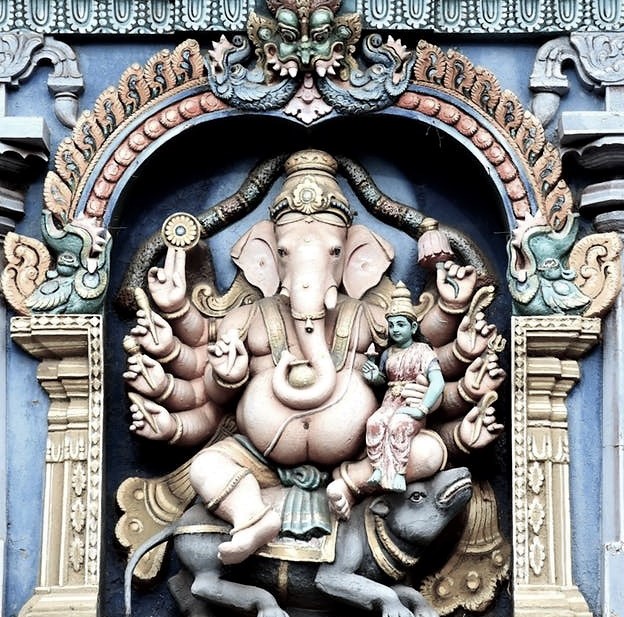- Special FeaturesFoundation YearSthala TreeTheerthamRathamArchitectureOther Speciality
- Sthala PuranTiruttani is the fifth abode of (Arupadai Veedu Six Houses). Sri Subramanyaswamy, `Muruga` to his devotees, in Tamilnadu. He fought a fierce battle with Surapadman, the demonking at Thiruchendur and taught a lession to him and his associates at Thiruchendur. Later Lord Muruga waged a Holy war on the defiant Tribal King of Vallimalai suppressed his ego and joined hands with his daughter, Valli, who is one of his Consorts. It is at this Holy THANIGAI HILL his anger (as a result of the war) subsided. THANIGAI meaning subsidence of a feeling in this case `anger`.
The present Temple is dating back to the Pallava period. Cholas, Vijayanagara rulers partronised it by giving munificent grants. Vijayanagara kings added II Prakara to the Temple. They also built gopura. Vahana mandapa has fresco paintings of Skandapurana story. Many Tamil saint poets sung songs in praise of the temple and God.
The history of Tiruttani dates back to a remote antiquity as evidenced by the Sacred Tamil literature and historical inscriptions discovered from this place. In the devotional hymns of various saint poets, the place is variously called as Tanigai, Seruttani, Kalunirakkunru, Tiruttani, Tanimalai, Tanigaimalai, Tanigaverpu, Kandachalam etc. In the stone inscriptions the place is called as Tiruttaniyal. The temple of Virattaneswara is stated to have been built by a certain Nambi Appi at Tiruttaniyal using granite stones, during the reign period of the Pallava king Aparajita Varman, who composed a verse in Venba metre in praise of the glory of the temple. In ancient days, Tituttani patronized the pilgrims, who had undertaken pilgrimage to Tirumala tiruppati (Sri Vengadam) via this place by arranging feeding charity for them. During the period of the Imperial Cholas, the name of the place was changed as Jananatha chaturvedi mangalam by Raja Raja I, which was stated to have been situated in Menmalai Taniyal Nadu, a sub division of Jayangonda Chola Mandalam. It may be noted here that Jananatha and Jayangonda are two of the many epithets borne by the Chola king Raja Raja I (985 and 1014 A.D). The temple of Lord Subrahmanya on the top of the Tiruttani hill dates back to a very remote antiquity. The name of the presiding deity of this temple was called as Lord Subrahmanya as found recorded in the Pallava Aparajita Varmans copper plate charter discovered from the neighbouring Velanjeri village. The same name continued with an additional name as Shunmuga during the 10th and 11th centuries and also later as well. The deity was called as Subrahmanya Pillaiyar in the 16th century as recorded in the inscriptions of Krishnadevaraya. The saint poet Arunagiri Nathar calls the deity as Sengamala Pillaiyar in his Tiruppugal hymns. The temple of Lord Vishnu, dedicated in His victory name as Sri Vjayaraghva swami in the village at the foot of the hill was built by a certain Narayana Raja, who was a descendent of Karikala Chola. Trittani has a recorded history of the benefactions conferred on various temples of the place, during the rule of the benevolent kings such as Aparajitta Varman Pallava ( 870 ndash 888 A.D) Parantaka Chola (907 ndash 955 A.D), Raja Raja Chola (985 ndash 1014 A.D), Rajendira Chola I (1012 -1044 A.D), Rajadhi Raja I (1018 ndash 1054 A.D), Vikarma Chola (1118 ndash 1136 A.D), Vijayaganda Gopala (1256 ndash 1285 A.D), Mara Varman Kula Sekhara (1314 ndash 1346 A.D), Virakampana Udaiyar, Devaraya II, Krishna Devaraya (1509 ndash 1529 A.D), Achyuta Devaraya etc.
- ArchitectureEastern gopuram and Western gopuram
Tower Name - Eastern gopuram and Western gopuram
Constructor Name - Vijayanagara Kings
No.of Kalasam - 3
Lightning Arrester - Yes
Tower Description - The Sri Subrahmanya swami temple is built in accordance with the Dravida style of temple architecture. All the other ancient temples in the town are also built in this order. While the original temple plan of Sri Subrahmanya swami atop the hill was simple having a square garbhagrigha, an antarala and a mahamandapa, the temple became a large complex with several sub shrines, three prakaras during the later periods. At present the temple is having three entrance towers (gopuras), distributed, one each at the entrance to each of the three prakaras on the eastern side. While the first gopura is a small edifice, with single tire gopura which was a later period addition to the temple, the second entrance gopura, after the flag staff and elephant (Iravata vahana) statue, in the 2nd prakara is a high tower, dating back to the Vijayanagara period. It is having a raised tower a strong kalkaram, which is having architectural designs. The tower above is a brick structure having kuta and sala designs and stucco figures. There is another tower on the western side of this prakara. At present a grand, modern 9 tire rajagopura is under construction in the eastern side, little away from the temple complex, at the culminating point of the 365 flight of steps, which starts at the ground level at the sacred sarvanapoigai tank. There is a square three tire dravida vimana, over the garbhagrigha of the main shrine, which is gilded with gold plates in the year 2010. These gopura towers add grandeur and elegance to the elevational profile of the temple complex.
- Alankar of Deity
- Prayers and BenefitsSpecial Vratas and PrayersOfferings to DeityStotras and Mantras
- Festivals
- Sodasha Upcharas
- Prasadhas
- Social ActivitiesAnnadhanMarriageEar BoringHead ShaveDanaasEducation FacilitiesSocial DrivesOther Activities
- Arjita Seva
- Tags

